1.What are the pros and cons when 2 major restaurant chains merge?
2.What are the HRM implications of this type of merger?
3. What,if any, significant changes to operations at Tim Hortons have you noticed since the merger?

same year, 1 analyst noted that Tim Hortons had been able to cut costs and increase expansion in early 2018, it was determined that there had been slower than anticipated store growth for the coffee and doughnut chain across North America over the past few years. As well, the Tim Hortons brand was engulfed by negative publicity in 2018 after some of its Ontario franchisees cut employee benefits and paid breaks in response to the province's minimum be interesting to track the ongoing progress and profitability of Tim Hortons, to monitor which other major restaurant chains merge in the future, and to evaluate the success of wage hikes. At the time, its owner, Restaurant Brands International Inc., said the actions did Clearly, the merger of 2 big brands has not been a smooth or simple process. It will CASE STUDY 2 Tim Hortons and Burgers-What Has This Meant for a Canadian Icon? In 2014, news feeds went wild with the announcement that Tim Hortons and Burger King were merging. But what has this meant for such a visible icon of Canada? When the merger was first announced, one of the more immediate concerns was what would happen to staff at both companies. Burger King, a subsidiary of a private Brazilian equity firm that has cut jobs at other companies when mergers have occurred, caused employees to question their future with Tim Hortons. Furthermore, shareholders were also concerned that there would be pressure on individual franchisees to cut corners and that executive pay would be excessive. From previous mergers done by the same company, including Heinz and Labatt, cost reductions did occur to make the companies more profit- able. Furthermore, the company's stated commitment to maintain staff levels at Tim Hortons only applied to the 16 corporate-owned restaurants. Other critics say that food items at both stores will become interchangeable, thereby reducing the need for separate distribution systems or separate physical locations. Revenues at Canadian Burger King restaurants were low, whereas Tim Hortons outlets were highly profitable. As such, there was some concern that any sharing of products would reduce the attraction consumers have for Tim Hortons, making it less profitable. So what did happen? In early 2015, about 350 employees lost their jobs at Tim Hortons. Terminated employees were mainly from its headquarters and regional offices. Later that to the US marketplace, neither of which would have occurred without the merger. In 2017, Tim Hortons Canadian franchisees formed an association and filed class action lawsuits against the master franchisor, accusing the head office of misusing advertising funds and not reflect the brand and blamed a "rogue group of franchisees. these transactions lumes as Company Downplays Impact of Timer








